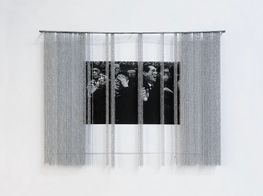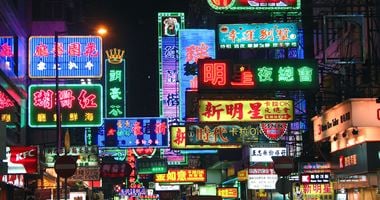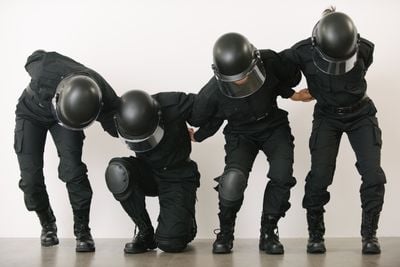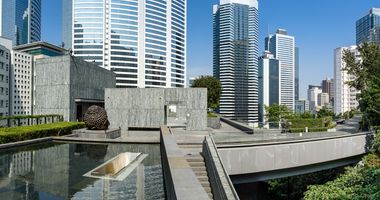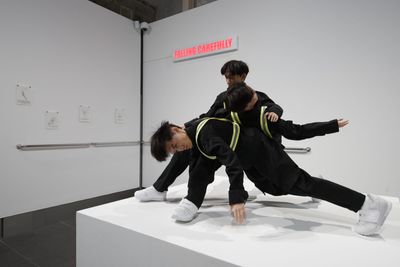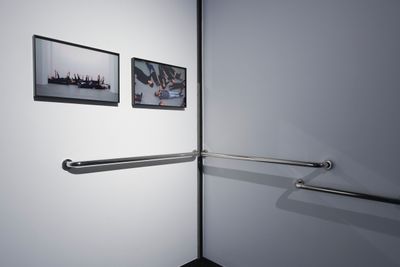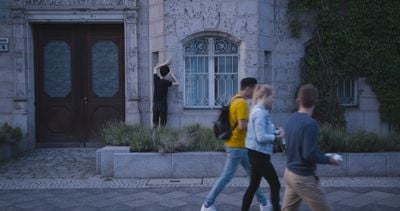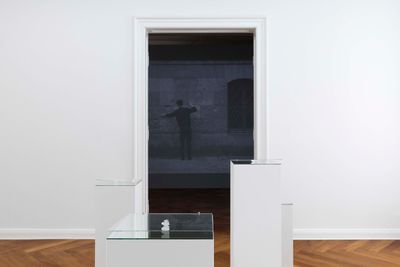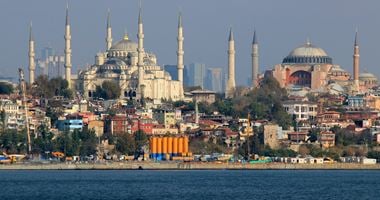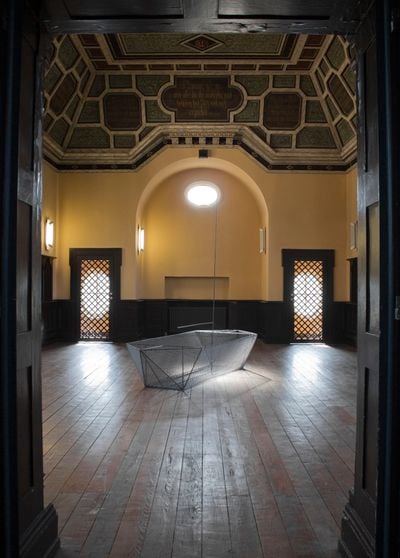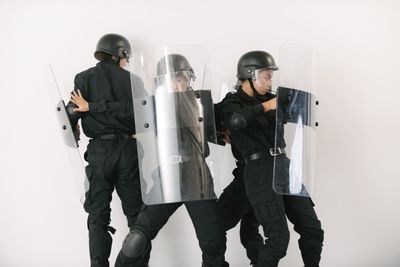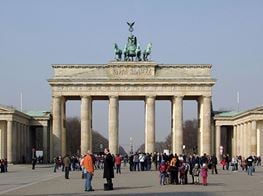Isaac Chong Wai on Falling Carefully
Isaac Chong Wai. Photo: Innsbruck International / Mia Maria Knoll.

Isaac Chong Wai. Photo: Innsbruck International / Mia Maria Knoll.
Born in Guangdong in 1990, Hong Kong artist Isaac Chong Wai casts his artistic lens from his current base in Berlin, using video, performance, and sculpture to visualise distributions of power and knowledge within human relationships and social systems.
Having received an MFA in Public Art and New Artistic Strategies from Bauhaus-Universität in Weimar in 2016, Chong's early works pinpoint specific sites and histories pertaining to the founding of the Weimar Republic.
In One Sound of the Histories (2015), for instance, Chong obtained access to Weimarplatz—a square built within a complex of administrative buildings that served the Nazi elite from 1936, named Adolf Hitler Square before this was dropped in 1945. Titled Weimarplatz in 1999 when the city achieved status as a European Capital of Culture, its function was removed altogether in 2005 once it became the atrium for a shopping centre. In his work, Chong invited participants to become living sculptures within the square, where they each recounted their personal memories in a stringent grid formation, allowing diverse, individual pasts to collide with the fraught history of the former Gauforum.
Concepts relating to individualism versus collectivism, and the personal versus the public were furthered in One Sound of the Futures (2016), a mass performance piece taking place simultaneously in Gwangju, Hong Kong and Wuhan, involving 100 participants in each city talking about their imaginary futures at the same time. Captured in video, the work is currently on view in the group exhibition Looking for Another Family, on view at the National Museum of Modern and Contemporary Art in Seoul (22 May–31 August 2020).
Chong's early investigations into Weimar's past also led him to the former juvenile prison, JVA Weimer, and in particular its surrounding fence, taking a portion of the robust yet semi-transparent material to fashion a boat. I Made a Boat in Prison – A Journey to the Shore (2015) took the form of a small boat, its function upended as a result of the material used.
Instead, Chong is captured laboriously pulling the boat forward in an accompanying video, further frustrating ideas around freedom and mobility. A series of minimalist paintings and drawings have followed suit, with the rhombic, intersecting lines conveying the dichotomy of freedom and constraint, the grille occasionally opened up to the surrounding space of the picture plane.
A series of these paintings are on view in the current group exhibition, Recurrence (26 June–29 August 2020), showing at Zilberman Gallery in Berlin. They are characteristic of Chong's practice, which sees themes and motifs reappearing throughout different bodies of work. Since 2018, the artist has worked on a series of performances titled 'Rehearsal of the Futures', which delve into the history of protest, filtering through repeated actions and movements to consolidate these into slow, gentle actions.
The second of these, titled Rehearsal of the Futures: Police Training Exercises and commissioned by M+ Museum in Hong Kong, singled out a series of training exercises activated a group of performers in police attire, their slowness restoring humanity to physical exertions of power.
Chong's representations of power and its distribution are rendered through characteristic tenderness in 'Rehearsals of the Future'—a defining quality of his work, as in his recent multimedia presentation at Asia Society in Hong Kong, titled Falling Carefully (2020). Showing in the group exhibition Next Act: Contemporary Art from Hong Kong (30 June–27 September 2020), which brings together works by Hong Kong artists to consider the shared history and collective memories of the city. The work constitutes metal railings around the installation's surrounding wall, with three models of the artist falling in unison at the centre: a reflection on the act of falling, and how the feeling of powerlessness that occurs with a fall can be reconsidered as a motion of mobility and solidarity.
In this conversation, Chong expands on the act of falling carefully and the key themes that run throughout his work.
TMTitled Falling Carefully (2020), your multimedia presentation at Asia Society, Hong Kong, looks at the act of falling, and how 'falling carefully' can be reconsidered as an act of solidarity. Could you elaborate on the idea of 'falling carefully', and how those who are knocked down might stand up stronger or move forward?
ICWIn Falling Carefully, I duplicated myself three times to create a sculptural work where you see three of me falling at the same time. The work examines how vulnerability empowers people to stand collectively, and, at the same time, reflects on the context of falling, asking: when do we fall? How might we fall? What makes us fall?
The act of falling explored in the work relates to the power structures behind body postures—who makes the decision or uses force to make people fall—and restores power to the body so that it is able to fall carefully. Many people throughout history have been knocked down by a higher authority or state power, and we see people who fall and are not able to stand again. Falling carefully might not make those who suffer stronger, but care and solidarity can allow all of us to move forward.
TMIn your previous solo exhibition at Zilberman Gallery in Berlin, What is the future in the past? And what is the past in the future? (6 September–9 November 2019), works were centred around localised histories, mostly in Germany and also Sarajevo in the video work The Silent Wall (2014), in which you are seen gently placing your hands over bullet holes in a wall in the city as if performing a reparation, while of course being unable to cover the holes all at once. This led to a Berlin iteration of the work, The Silent Wall—Berlin (2019).
Could you discuss the idea of the future expressed in the title?
ICWI have been working on the idea of how an imaginary past as 'future' is located in the past from which we look for possible futures. There is always a rupture between the body and the past, and I worked on the idea of how the body could respond to the past, sometimes, as a living memorial. The Silent Wall reflects my experience working in Sarajevo, where I saw bullet holes everywhere in the city left from the Bosnian War.
In 2019, I produced the same work in Berlin, where I live. I imagined what might have happened in front of the wounded walls—whether a soldier might have missed a target intentionally or unintentionally; whether anyone got injured. It's impossible for me to know, but I think it's important to remember scars from the past, so that we don't make the same scars again in the future.
We think of the past as being dead, but actually it's constantly changing—not the historical facts, but how we understand history and how we remember it.
In the video, I gradually lower the sound of the city to silence, creating silence for those who have been lost, and who fade away as they are forgotten. We think of the past as being dead, but actually it's constantly changing—not the historical facts, but how we understand history and how we remember it. The philosopher Günther Anders said, 'Everyone should try to remember one death, one past or one future.' By 'remembering' a death in the future, we are imagining a way to prevent something terrible from happening again.
This kind of personalising of historical events or deaths of those we don't know is about solidarity, and how we can support each other. In the end, changes of the past might be able to rescue the future.
TMWould you say you are offering solutions for reconciling or remembering the past?
ICWSolutions are important, but I don't think my works are offering solutions. I think one of the reasons my work is artistic is because it does not provide solutions, but questions. Ambiguity provides options for how we can think, by accepting obscurity—the unknown and the undefined—while compassion and solidarity can provide answers for how we can feel and act.
There is a tendency to polarise, because polarisation creates power through the power of knowing. Art does the opposite. Not being able to understand is sometimes what we need in order to ask questions, because when we say we understand something or we think we have found the solution, often it means there's a full stop.
TMThe exhibition at Zilberman Gallery presented 'Missing Space' (2019)—a series of glass sculptures moulded from bullet holes from walls in Berlin that are captured in the video work The Silent Wall—Berlin (2019), bringing the past into the future as a physical object. In doing so, they act as containers of memory, and yet they inhabit this ambiguous space where they are removed from their specific context and their associations are thus opened up. Could you discuss how you address this ambiguous space?
ICWIn Missing Space, I cast bullet holes on different walls in Berlin and transformed them into glass sculptures. The missing space caused by shooting is thus reconstructed into a transparent material. Each glass sculpture rests between a mirror and a glass plate on which the GPS location of each bullet hole is printed. Upon impact, damaged portions of the wall would have fallen to the ground, becoming sand and dispersing in space. Glass is made of sand and is transparent. So, there is a transformation of the sand that has been gathered together to become a 'physical ghost'.
The transparency of the material responds to the environment and light to reveal its form, allowing its existence to capture the present moment. The mirror also extends the present moment, which is an intangible space. The space between the mirror and the GPS glass plate is defined by the thickness and angle of the glass sculpture—a missing space, which is sandwiched between the past and the future. When the gap is wider, it means the glass is stronger, however the thickness of the glass also represents the power of the gunshot that created that particular bullet hole. In the end, the space becomes ambiguous, as it has been translated many times from a random spot in the city to a precarious object treated with attention and care.
TMYour sculpture I Made a Boat in Prison – A Journey to the Shore (2015) takes the form of a small boat made out of fence that has been cut from the fence of the former juvenile prison in Weimar, JVA Weimar. First shown in Weimar, the work was then presented in Istanbul in 2019, where the symbol of the boat will have had different associations. To what extent do your works depend on symbology? How do you approach materials and context to open up these symbols?
ICWIt's a strong symbol, but at the same time it's weak, as it's made out of fence, so it sinks. When a symbol is rendered 'useless', is it still needed? I work with people's understanding of the order of things. There are knowledges that we all share, relating to certain images in different cultures—people have different ideas, and the interpretation of the boat would have varied in Berlin and in Istanbul. The boat is made out of fence, which is see-through. In a prison, that fence is constructed to contain people, but it also means that those inside can be seen from the outside.
Meanwhile, the symbol of the boat generally reflects ideas of mobility, accessibility, and movement, but in the video the boat does not move on its own—it's me who made it move, and by using fence as a material, the fragility of the object is amplified as a symbol. Using different materials allows symbols to be understood differently. It's about the potentials of representation, and how these drive us to think and discuss what we normally perceive.
TMI find it interesting that you use specific, localised histories in order to address universal questions. How does your sense of identity inform your practice?
ICWI am from Hong Kong, born in Guangdong. There is always in-betweenness in Hong Kong identity, which is reflective in my works. However, being able to travel in different countries and living in Germany, my sense of identity is becoming blurred by divergent political systems, cultures, histories, and imaginations. I don't necessarily point at Hong Kong in my work directly, but I think Hong Kong is part of me, and most likely, people can see the values that I believe in from my works and discover the shadow of Hong Kong.
My work looks at power structures and the decentralisation of representations of power, while looking at how power might be centralised in the body as a container.
TMYou frequently blend the present and the past in your works, which activates histories, bringing them forward for reconciliation. How do you deal with the temporal gap between past and present when that gap seems to be tightening? Your performance works, 'Rehearsal of the Futures', for instance, are strangely prophetic when thinking about the waves of protests in Hong Kong.
ICWThe history of protest repeats itself. We see that in writing in signs that people are holding today, such as: 'My arms are tired from holding this since since the 1960s'. It's good that we can protest today, but the reason we protest is because we believe something is wrong. With my work Rehearsal of the Futures: Is the World Your Friend? (2018), I looked at repetitive body postures, gestures, and movements of protestors, transforming these into acts of slowness and stillness, allowing possible futures to be imagined.
The second performance of this series, In Rehearsal of the Futures: Police Training Exercises (2018), was commissioned by M+ Museum. Referencing training exercises from police academies, I choreographed the movement of uniformed riot police into a tortuously slow speed, allowing for tenderness. The paradoxical gentleness nullifies the physical violence imposed on bodies by structural violence. Holding one another's hands to practice making a fence, along with a fallen fence; training how to fall instead of stand; transforming a fight into slow motion... the subtle movements force us to closely read the vocabulary of protest.
It might be prophetic, but I think it is more like witnessing the same language from the past being spoken again. Protesting is a global language—of course, not totally global, because there are many places where protests are forbidden, but all protests share a certain language, which is continually developing.
TMHow so? When you were researching that vocabulary of protest, were there any surprising anomalies or repetitions that you found?
ICWWith technology, protestors are developing certain strategies. Like we see in art and representation, a certain event might relate to a certain image—like a sunflower, a vest, or an umbrella. In Hong Kong, protesters cover their faces because of facial recognition. The movement of crowds is also dependent on social media, whereas previously it might have been the radio. The presence of the body is very important.
Conversely, the absence of the body becomes a collective body. These are things that I've been working on, in relation to collectivity and individualism, and how collectivity becomes a shelter that protects. My work looks at power structures and the decentralisation of representations of power, while looking at how power might be centralised in the body as a container.
TMYour exhibition at the Centre for Contemporary Chinese Art in Manchester was intended to open this July but has been postponed to 2021 as a result of the coronavirus pandemic. What will you be showing there?
ICWThere is a lot of uncertainty at the moment, so I will keep it more flexible. I was planning to show a series of new works including installation, painting, objects, video, and performance investigating social structures and how power is distributed in the political sphere, while imposing an imaginary future without a totalised leader.—[O]

